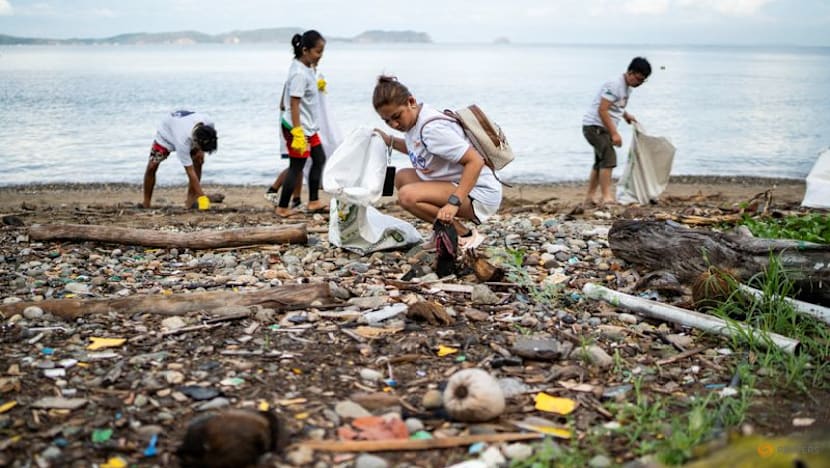Commentary: Plastic pollution isn’t just trash – it’s alive with microbes that threaten our health
Plastics will not only choke coastlines but also incubate antibiotic resistance, disrupt food webs and infiltrate the human body, says SCELSE researcher Stephen Summers.

People collect plastic waste on a beach during a coastal cleanup programme that provides rice to volunteers in exchange for plastic waste, in Mabini, Batangas province, Philippines, Jun 15, 2024. (Photo: Reuters/Lisa Marie David)

This audio is generated by an AI tool.
SINGAPORE: The United Nations’ latest round of plastic treaty negotiations in Geneva has ended in disappointment. Despite two draft texts, nearly 180 countries failed to reach consensus, leaving the world without a binding agreement to curb plastic pollution.
This failure will have an impact on public health. Plastics are more than unsightly litter – they are colonised by microbes, turning into living “plastispheres” that spread pathogens, concentrate toxic chemicals and alter ecosystems. In tropical waters, these microbial communities form rapidly and thrive in ways we are only beginning to understand.
This microbial lens reveals a hidden danger in plastic pollution. Without action, plastics will not only choke coastlines but also incubate antibiotic resistance, disrupt food webs and infiltrate the human body. The crisis is deeper and more insidious than most policymakers realise.
PLASTICS ARE NOT INERT
When we talk about plastic pollution, we tend to think of littered coastlines or garbage patches in oceans. But plastic does not remain static once it enters the environment.
In my work at SCELSE, we study how plastics are rapidly colonised by bacteria and other microbes, forming dense communities known as plastispheres. These plastispheres are not harmless. Research shows they can act as “floating petri dishes”, concentrating pollutants and serving as vectors for antibiotic-resistant bacteria.
In tropical waters such as Singapore’s, the process is accelerated. Microbial communities colonise plastics faster and with greater diversity compared to temperate seas. Preliminary data suggests these communities are enriched in microbes that consume or break down hydrocarbons (oil-like compounds), and in bacteria carrying genes that make them harder to kill.
These changes ripple outward. If key microbial players are replaced or dominated by these groups, plankton communities may shift, affecting the fish that depend on them and, ultimately, the seafood we eat.
For public health, the risk is twofold. Resistant bacteria can move from the sea and come into contact with humans via food, water and coastal recreation, and chemical changes in plastispheres may increase the release of toxins that accumulate in seafood consumed by people.
This microbial dimension of the plastic crisis is rarely discussed in negotiations. Yet it is critical. Plastics are not inert pollutants – they are chemically and biologically active surfaces that disrupt ecosystems at the microbial level.
HARMFUL AND HELPFUL MICROBES
Recent work led by my colleague Cao Bin and his team shows just how complex this picture is. Sampling plastic debris across 14 coastal sites in Singapore, they found both threats and opportunities within the plastisphere.
On the one hand, the debris hosted potentially harmful microbes capable of spreading across habitats, including coral reefs and mangroves. On the other, the team also identified potential plastic-eating bacteria such as Muricauda and Halomonas – organisms that could one day help us develop biologically driven solutions for plastic waste management.
Left unchecked, marine plastics can spread pathogens and resistance genes. But with research investment, they could also point us toward microbial solutions to degrade and detoxify plastics in the future.
PLASTICS AND HUMAN HEALTH
The danger is not confined to oceans. Microplastics have been detected in human blood, placental tissue and breast milk. In Singapore, NUS Tropical Marine Science Institute researcher Dr Sandric Leong and his team found microplastics in prawns sold for consumption.
These findings bring the crisis directly to our dinner tables. We can measure plastic uptake in the body, but we do not yet know what this means for our cells, immune systems, or long-term health. The science is still catching up, but the exposure is already here.
Against this backdrop, biodegradable plastics are often promoted as a fix. However, bioplastics such as polylactic acid degrade only under industrial composting conditions and persist in seawater, fragmenting into smaller pieces that continue to pollute. Without international standards for biodegradability across environments, such solutions risk being little more than greenwashed substitutions.
WHAT CAN BE DONE LOCALLY
With global talks stalling, what can ordinary people and communities do? Here are three areas where local action matters.
First, we can cut down on single-use plastics. Market forces shape production. Every time we refuse unnecessary packaging, bring our own bags, or choose refillable options, we lower the demand for disposables. Consumer behaviour alone cannot solve the problem, but it can undermine the economic incentives that keep virgin plastic production rising.
Second, we can support cleanup and monitoring efforts. While prevention is crucial, plastics already in the environment continue to cause harm. Community cleanups, citizen science initiatives and monitoring projects help remove waste, provide valuable data on pollution sources and build public awareness.
Third, we can push for stronger regulation at home. Even as global treaties falter, national and municipal governments can act. Bans on single-use items, levies on virgin plastic production and dedicated funding for research and waste management all make a difference. Policy shifts in Canada and several US states were informed by cleanup data – showing that evidence-based, local action can move the needle.
THE COST OF NORMALISATION
My greatest fear is that we will normalise plastic pollution – that we will come to accept it as the background of modern life, despite mounting evidence of ecological disruption, biodiversity loss and human health risks.
The science is unambiguous: Plastics are biologically active hazards. They alter microbial life, concentrate toxic chemicals and infiltrate our food chain. If global negotiations cannot move quickly enough, then communities, consumers and policymakers must not wait.
Our actions – individually and collectively – remain the most immediate force we have to curb demand, protect ecosystems and prevent a public health crisis from becoming irreversible.
Dr Stephen Summers is Senior Research Fellow at SCELSE, a multidisciplinary biofilm & microbiome research centre in Singapore.


















